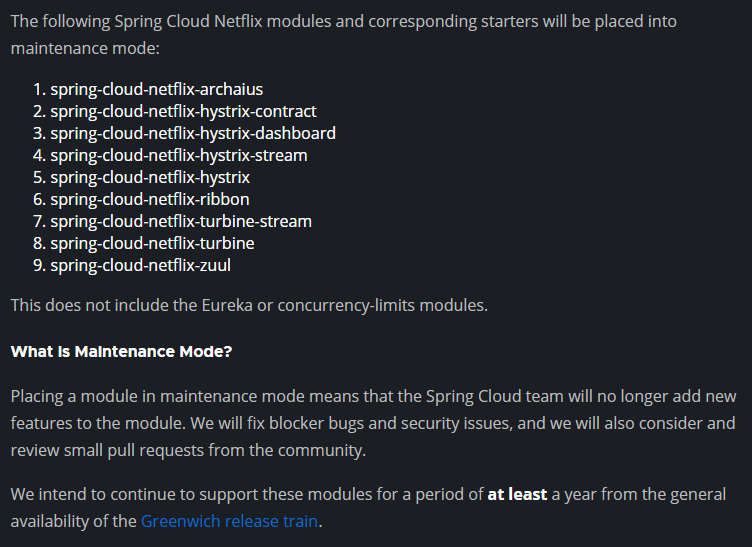使用 Spring Cloud LoadBalancer 实现客户端负载均衡
使用 Spring Cloud LoadBalancer 实现客户端负载均衡
作者:Grey
原文地址:
博客园:使用 Spring Cloud LoadBalancer 实现客户端负载均衡
CSDN:使用 Spring Cloud LoadBalancer 实现客户端负载均衡
背景
在Spring Cloud G 版发布时提到,
Spring Cloud Netflix 那套组件很多都进入了维护期,如下表所示

同时,针对一些组件,Spring 官方给出了一些替代方案

针对 spring-cloud-ribbon 这个负载均衡组件,Spring 官方提出的替换解决方案是 Spring Cloud Loadbalancer。本文主要通过一个示例介绍了 Spring Cloud Loadbalancer 的基础使用。
环境
JDK 1.8+
Maven 3.5+
Spring Boot 版本:2.7.5
Spring Cloud 版本:2021.0.5
项目结构和说明
- spring-cloud-loadbalanced-usage:父项目名称
- server : 服务端端模块
- src/
- pom.xml
- client : 客户端模块
- src/
- pom.xml
- pom.xml:父项目 pom 配置
- server : 服务端端模块
流程
整个过程如下示例图

注:Spring Cloud Loadbalancer 是在客户端实现负载均衡策略。
代码说明
服务端主要暴露一个服务,未做特殊配置
@GetMapping("/greeting")
public String greet() {
log.info("Access /greeting");
int randomNum = rand.nextInt(greetings.size());
return greetings.get(randomNum);
}
客户端的核心配置如下,主要是针对负载均衡配置:
package git.snippet.client.config;
import org.springframework.cloud.client.DefaultServiceInstance;
import org.springframework.cloud.client.ServiceInstance;
import org.springframework.cloud.client.loadbalancer.LoadBalanced;
import org.springframework.cloud.loadbalancer.annotation.LoadBalancerClient;
import org.springframework.cloud.loadbalancer.core.ServiceInstanceListSupplier;
import org.springframework.context.annotation.Bean;
import org.springframework.context.annotation.Configuration;
import org.springframework.context.annotation.Primary;
import org.springframework.web.reactive.function.client.WebClient;
import reactor.core.publisher.Flux;
import java.util.Arrays;
import java.util.List;
@Configuration
@LoadBalancerClient(name = "server")
public class WebClientConfig {
@LoadBalanced
@Bean
WebClient.Builder webClientBuilder() {
return WebClient.builder();
}
@Bean
@Primary
ServiceInstanceListSupplier serviceInstanceListSupplier() {
return new ServiceInstanceListSupplier() {
@Override
public String getServiceId() {
return "server";
}
@Override
public Flux<List<ServiceInstance>> get() {
return Flux.just(Arrays.asList(
new DefaultServiceInstance(getServiceId() + "1", getServiceId(), "localhost", 8090, false),
new DefaultServiceInstance(getServiceId() + "2", getServiceId(), "localhost", 9092, false),
new DefaultServiceInstance(getServiceId() + "3", getServiceId(), "localhost", 9999, false)));
}
};
}
}
其中 @LoadBalancerClient(name = "server") 指定了 服务端的名称;
getServiceId()指定了服务端的服务 ID;
serviceInstanceListSupplier()方法中列出了三个服务端实例的地址;
new DefaultServiceInstance(getServiceId() + "1", getServiceId(), "localhost", 8090, false)
new DefaultServiceInstance(getServiceId() + "2", getServiceId(), "localhost", 9092, false)
new DefaultServiceInstance(getServiceId() + "3", getServiceId(), "localhost", 9999, false)
有了这个配置,在客户端的 Controller 中,做如下注入即可
package git.snippet.client.controller;
import org.springframework.cloud.client.loadbalancer.reactive.ReactorLoadBalancerExchangeFilterFunction;
import org.springframework.web.bind.annotation.RequestMapping;
import org.springframework.web.bind.annotation.RequestParam;
import org.springframework.web.bind.annotation.RestController;
import org.springframework.web.reactive.function.client.WebClient;
import reactor.core.publisher.Mono;
@RestController
public class HiController {
private final WebClient.Builder loadBalancedWebClientBuilder;
private final ReactorLoadBalancerExchangeFilterFunction lbFunction;
public HiController(WebClient.Builder loadBalancedWebClientBuilder, ReactorLoadBalancerExchangeFilterFunction lbFunction) {
this.loadBalancedWebClientBuilder = loadBalancedWebClientBuilder;
this.lbFunction = lbFunction;
}
@RequestMapping("/hi")
public Mono<String> hi(@RequestParam(value = "name", defaultValue = "Mary") String name) {
return loadBalancedWebClientBuilder.build().get().uri("http://server/greeting").retrieve().bodyToMono(String.class).map(greeting -> String.format("%s, %s!", greeting, name));
}
@RequestMapping("/hello")
public Mono<String> hello(@RequestParam(value = "name", defaultValue = "John") String name) {
return WebClient.builder().filter(lbFunction).build().get().uri("http://server/greeting").retrieve().bodyToMono(String.class).map(greeting -> String.format("%s, %s!", greeting, name));
}
}
启动并测试
首先启动 server,注意:
启动 server 的时候,需要启动多实例,且每个实例要定义 VM options
实例一定义 VM options 为 -Dserver.port=8090;
实例二定义 VM options 为 -Dserver.port=9092;
实例三定义 VM options 为 -Dserver.port=9999。
如果使用 IDEA Intellij,配置方式如下

三个 Server 启动后,接下来启动 client,运行 ClientApplication,启动完毕后,多次访问: http://localhost:8888/hi
可以通过每个 server 实例的运行日志,查看到每个实例都轮流获取到了请求,实现了负载均衡。
完整代码
见:spring-cloud-loadbalancer-usage
参考文档
Spring Cloud Greenwich.RELEASE is now available
Client-Side Load-Balancing with Spring Cloud LoadBalancer
使用 Spring Cloud LoadBalancer 实现客户端负载均衡的更多相关文章
- 服务注册发现Eureka之三:Spring Cloud Ribbon实现客户端负载均衡(客户端负载均衡Ribbon之三:使用Ribbon实现客户端的均衡负载)
在使用RestTemplate来消费spring boot的Restful服务示例中,我们提到,调用spring boot服务的时候,需要将服务的URL写死或者是写在配置文件中,但这两种方式,无论哪一 ...
- Spring Cloud Ribbon实现客户端负载均衡
1.构建microservice-consumer-movie-ribbon项目,在pom.xml中引入ribbon依赖 在引入Eureka依赖的时候,默认里面含有ribbon依赖 2.添加@Load ...
- Spring Cloud 客服端负载均衡 Ribbon
一.简介 Spring Cloud Ribbon 是一个基于Http和TCP的客服端负载均衡工具,它是基于Netflix Ribbon实现的.它不像服务注册中心.配置中心.API网关那样独立部署, ...
- Spring Cloud - 切换Ribbon的负载均衡模式
Spring Cloud Ribbon是一个基于HTTP和TCP的客户端负载均衡工具,它基于Netflix Ribbon实现.通过Spring Cloud的封装,可以让我们轻松地将面向服务的REST模 ...
- 2.【Spring Cloud Alibaba】实现负载均衡-Ribbon
负载均衡的两种方式 如何实现负载均衡 目前已经实现让A总能找到B,如何实现负载均衡 负载均衡的两种方式 服务器端负载均衡 客户端负载均衡 使用Ribbo实现负载均衡 Ribbon是什么 ==Netfl ...
- Spring Cloud微服务Ribbon负载均衡/Zuul网关使用
客户端负载均衡,当服务节点出现问题时进行调节或是在正常情况下进行 服务调度.所谓的负载均衡,就是当服务提供的数量和调用方对服务进行 取舍的调节问题,在spring cloud中是通过Ribbon来解决 ...
- 4.Spring Cloud初相识--------Feign负载均衡
前言: 在上一节里,我们学习了ribbon的使用. 我们了解到ribbon是一个客户端负载均衡机制. 而我们今天要讲的Feign呢,也是一款客户端负载均衡机制. 或者这样说,Feign封装了ribbo ...
- 撸一撸Spring Cloud Ribbon的原理-负载均衡策略
在前两篇<撸一撸Spring Cloud Ribbon的原理>,<撸一撸Spring Cloud Ribbon的原理-负载均衡器>中,整理了Ribbon如何通过负载均衡拦截器植 ...
- Spring Cloud Gateway Ribbon 自定义负载均衡
在微服务开发中,使用Spring Cloud Gateway做为服务的网关,网关后面启动N个业务服务.但是有这样一个需求,同一个用户的操作,有时候需要保证顺序性,如果使用默认负载均衡策略,同一个用户的 ...
- 【Spring Cloud学习之三】负载均衡
环境 eclipse 4.7 jdk 1.8 Spring Boot 1.5.2 Spring Cloud 1.2 主流的负载均衡技术有nginx.LVS.HAproxy.F5,Spring Clou ...
随机推荐
- Typora的破解
Typora是什么? Typora是一款支持实时预览的Markdown文本编辑器.支持即时渲染技术,这也是与其他Markdown编辑器最显著的区别.即时渲染使得你写Markdown就想是写Word文档 ...
- 第八十篇:Vue购物车(一) 购物车基本框架
好家伙,又是购物车 来吧,这是参照黑马的课程写的一个购物车 目录结构如下: 1.首先组件导入, Counter.vue <template> <div class="num ...
- HC32L110(四) HC32L110的startup启动文件和ld连接脚本
目录 HC32L110(一) HC32L110芯片介绍和Win10下的烧录 HC32L110(二) HC32L110在Ubuntu下的烧录 HC32L110(三) HC32L110的GCC工具链和VS ...
- KingbaseES 转义字符
在SQL标准中字符串是用单引号括起来的,在KingbaseES中遵守了该标准,如果在字符串中需要使用到单引号,就需要对其进行转义. 方式一:使用E和反斜杠进行转义 方式二:直接用一个单引号来转义 在K ...
- K8S_CNI
CNI 插件 定义: Container Network Interface 容器通用接口 K8S 中可选的 CNI 插件如下: Flannel 较流行 Calico 性能棒,比Flannel快1% ...
- vscode用户自定义代码中如何表示table空格
"Print to phpfuntion": { "scope": "php", "prefix": "pfu ...
- 【学习笔记】GBDT算法和XGBoost
前言 这一篇内容我学了足足有五个小时,不仅仅是因为内容难以理解, 更是因为前面CART和提升树的概念和算法本质没有深刻理解,基本功不够就总是导致自己的理解会相互在脑子里打架,现在再回过头来,打算好好总 ...
- MySQL5.7.15数据库配置主从服务器实现双机热备实例教程
环境说明 程序在:Web服务器192.168.0.57上面 数据库在:MySQL服务器192.168.0.67上面 实现目的:增加一台MySQL备份服务器(192.168.0.68),做为MySQL服 ...
- 使用 Loki 进行日志报警(二)
转载自:https://mp.weixin.qq.com/s?__biz=MzU4MjQ0MTU4Ng==&mid=2247492374&idx=1&sn=d09f6db623 ...
- Shell分析日志文件
文章转载自:https://mp.weixin.qq.com/s/o63aIM2p9rc2OjhxiC6wgA 1.查看有多少个IP访问: awk '{print $1}' log_file|sort ...
